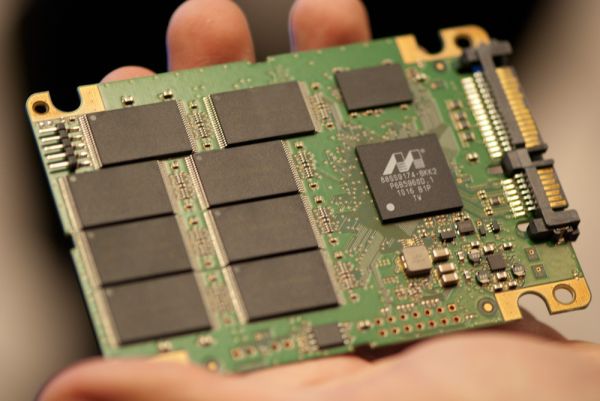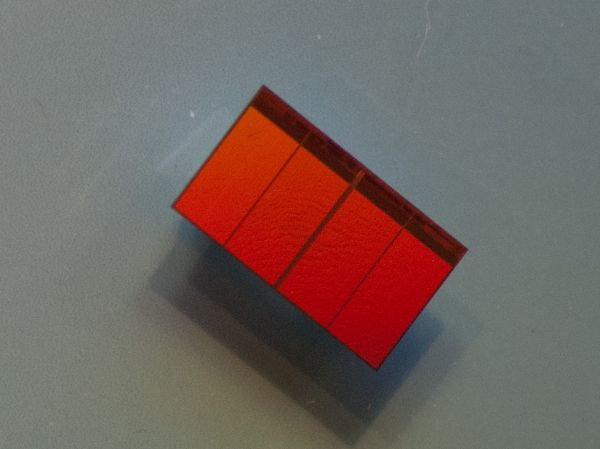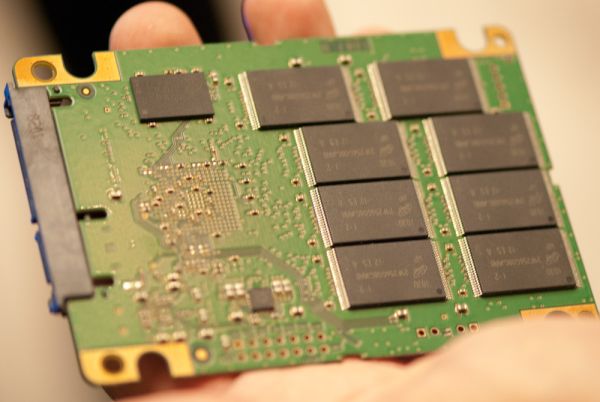Micron's RealSSD C400 uses 25nm NAND at $1.61/GB, Offers 415MB/s Reads
by Anand Lal Shimpi on January 4, 2011 8:20 PM EST- Posted in
- Storage
- SSDs
- Micron
- CES 2011
- RealSSD C400
Here’s a little deja vu for you. At last year’s Storage Visions (a small storage show that precedes CES) Micron announced its first 6Gbps SSD, the RealSSD C300. Although met with its fair share of growing pains in the form of firmware issues, the C300 ended up being a competent performer throughout most of 2010.
This year, once again at Storage Visions, Micron announced its next generation SSD: the RealSSD C400. Based on the same architecture as the C300, the C400 is a combination of IMFT 25nm NAND, a slightly tweaked controller and a significant improvement in firmware.
The controller is still a Marvell 6Gbps solution, while the firmware is all Micron’s own development. As Micron (and SandForce) have proved in the past, it’s not so much the raw processing power of the controller but the architecture of the firmware that really matters.
The controller is still paired with a 256MB DRAM to cache LBA to NAND page mapping and act as a scratch area for the Marvell controller. Unlike the C300 however, the 64GB version of the C400 will only have a 128MB cache (the 64GB C300 had a 256MB cache).
Despite using IMFT’s 25nm NAND (at roughly 3,000 program/erase cycles per NAND cell), Micron claims the C400 will last for at least 72TB of writes over its lifetime which is identical to how long Micron claims the C300 will last. I asked Micron why the C400 didn’t incur any endurance penalty with the switch to 25nm, its answer was simple: the C300 was conservatively rated. Even though the C300 NAND cells will last longer, both it and the C400 will at least make it to Micron’s 72TB rating. Micron also mentioned to me that it writes more than 72TB of data to its drives during development, so this is a verified rating.
The move to 25nm NAND gives us one major improvement: cost. The 512GB C400 will be priced at $825 in 1,000 unit quantities - that works out to be $1.611 per GB. The 256GB drive will go for $425, the 128GB at $210 and the 64GB somewhere above $100. As 25nm production ramps up I wouldn’t be too surprised to see SSD prices drop down to the magical $1/GB price point.
Price isn’t the only benefit of the C400, performance should be much improved as well. Micron is claiming sequential read speeds of 415MB/s and sequential write speeds of up to 260MB/s (256/512GB drives). The 128GB drive is good for up to 175MB/s sequential writes. Random write performance is unknown at this point but I heard Micron mention something around 50,000 4KB random write IOPS.
The raw specs are much better than what we have today however not quite as high as what SandForce is promising with its SF-2000. The difference is availability, while we saw the C400 in action and it’ll be shipping in February, SF-2000 drives are more than a quarter away.
Crucial, Micron’s retail arm, will be selling the C400 under its brand as the Crucial M4.













39 Comments
View All Comments
AnnonymousCoward - Tuesday, January 4, 2011 - link
How about an estimate on the BOM cost of that board?PeterO - Wednesday, January 5, 2011 - link
When NAND cell dies, does the controller disable the cell's entire logical block of cells? thxcactusdog - Wednesday, January 5, 2011 - link
You would struggle to notice any difference if it was installed on the Intel controller or the 6GB/s controller. Its not a real 6GB/s drive, they dont seem to exist yet.AnnihilatorX - Wednesday, January 5, 2011 - link
What are you on about, even C300 can use SATA 6Gb/sSATA 3Gb/s won't sustain 400MB/s sequential reads quoted in the article.
http://i1190.photobucket.com/albums/z449/c300-revi...
from
http://www.overclock.net/ssd/859715-crucial-realss...
therealnickdanger - Wednesday, January 5, 2011 - link
I think what he means, assuming I understand properly, is that with SATA-3Gbps, we have drives that top out at 280MB/s. By extension, one would expect SATA-6Gbps drives to reach 560MB/s, assuming overhead scales the same. I agree that 415MB/s is not impressive in this regard.For a 100% increase in theoretical bandwidth, getting a drive with only 50% greater bandwidth is disappointing. Is this due to too few channels in the C-series? Is there that much overhead with SATA-6Gbps?
Either way, it seems that the only way to achieving truly greater speed is PCIe with a REVO-style RAID-0 SSD.
strikeback03 - Wednesday, January 5, 2011 - link
If there were already drives that could saturate SATA-6Gbps users would be crying for an even faster standard immediately. SATA-3Gbps still isn't really pushed by mechanical HDDs and wasn't close to saturated before SSDs, so I think it is a good thing the standard isn't maxed out yet.therealnickdanger - Wednesday, January 5, 2011 - link
Yeah, we wouldn't want technology that was awesome and too fast or something...</sarcasm>
For real, I will wait for PCIe drives to drop in price. It's clear that 6Gbps isn't going to cut it in the long run - even when it is eventually saturated.
Spivonious - Wednesday, January 5, 2011 - link
If I write a bunch of data to one of these, and then stick it in a closet for 5 years, will my data still be readable?therealnickdanger - Wednesday, January 5, 2011 - link
Five years, yes it should. I've seen research and studies that indicate that the less NAND is written to, the longer it lasts. IIRC, 10 years of data retention should be simple with any modern NAND device. To what extent 10 years of retention is affected by addition writes or rewrites, I don't have hard numbers.rickcain2320 - Wednesday, January 5, 2011 - link
Your bigger problem in 5 years will most likely be plugging the thing back in because its interface is obsolete and nobody supports it anymore.